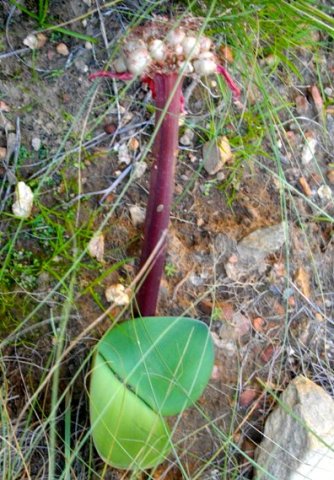Haemanthus sanguineus

Author: Ivan Lätti
Photographer: Ivan Lätti
Haemanthus sanguineus is a long-lived geophyte that may reach 30 cm in flower.
The broad, leathery leaves are usually glaucous with some red along their margins. Neither feature is clearly evident on the still underdeveloped leaves in picture. The leaves are usually wider than long, in the sense that length is measured from tip to base. An Afrikaans common name, velskoenblaar (skin shoe leaf), was prompted by the feature of leaf appearance.
Flowering occurs from midsummer to midautumn, before the two prostrate leaves appear. This plant was seen near the river in Meiringspoort during April shortly after flowering. It is still pushing out the new leaves, the fruits having already formed.
The species distribution is in the Western Cape from Clanwilliam southwards and along a broad strip in the south of the country through the Little Karoo and along the coast to the west of the Eastern Cape, beyond Gqeberha (Port Elizabeth).
The plants habitat is rocky outcrops and gravelly loam soils in variable fynbos, shrub and scrub veld. These are places where tortoises, known for their contribution to seed dispersal of this plant when they consume the fruit, still roam if people are kind to them. The species is not considered to be threatened in its habitat early in the twenty first century (Vlok and Schutte-Vlok, 2015; Duncan, 2010; http://redlist.sanbi.org).

